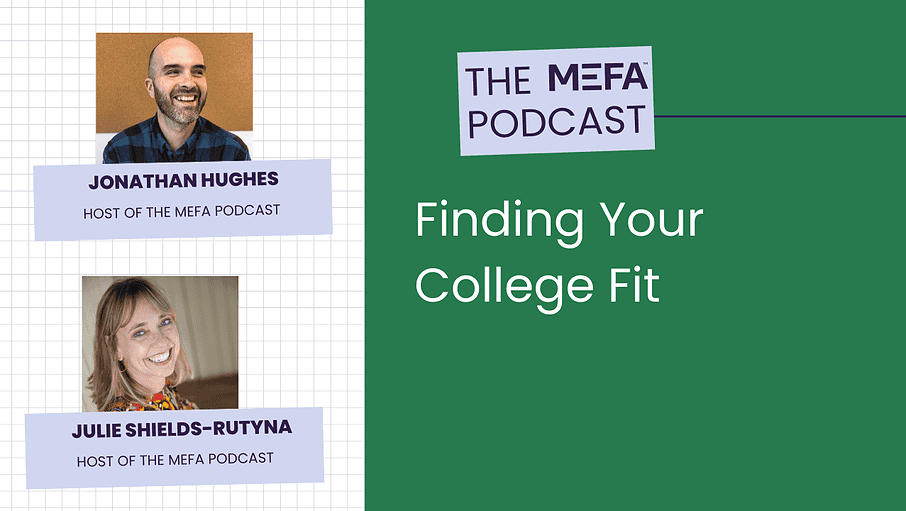

Resources Mentioned in this Episode
Jonathan Hughes: [00:00:00] All right. Welcome everyone to The MEFA Podcast. My name is Jonathan Hughes and I’m Julie Shields-Rutyna. How are you, Julie?
Julie Shields-Rutyna: Oh, I’m doing great.
Jonathan Hughes: We have got a great show for you today. And this is one of the things, this is one of the great things actually about being in this space. Like we are, we have so many friends and colleagues and networks in the higher education space in Massachusetts and academics, and doing interesting.
And we get to share that work and we get to host it sometimes. And that’s what we’re going to do here today. So a few weeks ago, Julie, you hosted a webinar featuring Dr. Amanda Sterk, Director of College and Career Advising for Method Learning, and Dr. Timothy Poynton, Associate Professor at UMass Boston. [00:01:00] And we’re going to share some of the highlights from that webinar. But Julie, do you want to tell everyone about, first of all, who they are and what they talked about?
Julie Shields-Rutyna: They put on a really great webinar for us. And we’re going to link to that in the show notes, I assume. As in every webinar we highlight, there’s so much that can’t fit in here. So if folks really want to check out the full webinar. They can do and so the title was six keys to finding a good college fit. And that really gets to the heart of the matter, right? That’s what people want to know. Here we’re having all these important conversations around financial aid and loans and scholarships, essays, all the worthwhile topics, but all to support students going to a college that they will love and be successful at.
Jonathan Hughes: And they wrote a book together as well, is that right?
Julie Shields-Rutyna: Yeah, it’s really more than a book. It’s like a workbook and it’s a whole curriculum and it’s called College Unmazed. And so there’s the workbook part and there are free downloads [00:02:00] online and other components too.
Jonathan Hughes: And so we should probably say, anytime that we have a guest, we’re going to start doing this every time we have guests on the show, I think that are authors or what have you. But anytime we have a guest. Like this on the show, who has a definite viewpoint. We’re bringing it to folks attention because we think it may be of interest to them. So we’re not necessarily endorsing any products or anything like that. MEFA always feels that it’s our role to give you, the student, the parent. information that you don’t have or perspective that might interest you and that you make your own decisions. And I think this definitely this content will be of interest to families and students.
Julie Shields-Rutyna: Yeah. And so speaking of making decisions great segue that Dr. Poynton and Dr. Sterk are trying to help, students do, and families do. Let’s hear the first clip here. And we said the focus here are the six keys to finding a good college fit. And we’re going to [00:03:00] hear Dr. Timothy Poynton talk about what those are, and the metrics that students can use to judge whether or not a college will be a good fit for them.
Dr. Timothy Poynton: And these are the six keys of college fit. We’ll go over these somewhat quickly here and we’ll talk about them a little bit more as we go through the rest of the presentation, but the six keys are just going from the top counter or from the top clockwise are we’ve got academic match.
So how well does a college match? Your student or you if you are the student that’s things like how well do your academic qualifications fit like your ACT and SAT scores, your GPA and the curriculum that you’ve taken in high school compared to what the college is looking for in their students in terms of the average GPA that accepted students have.
And we’re also looking here in academic match at the academic environment. For example, we use the student to faculty ratio to try and get a sense of how big or how small the classes are and how many faculty are available for each student in the career match key. We’re looking at how well is this college situated to help me in my career development?
Essentially. [00:04:00] Is there mentoring available? What’s their career counseling program look like that they offer? What kinds of jobs? Placement services. Do they offer? Do they have a robust internship program there? We got the financial match, which is a critically important one, of course. Here in the financial match key, we’re looking for and helping students and families evaluate the information that’s available in terms of the cost.
Looking at the difference between and we’ll look at this a little bit later. What we call the sticker price. And the net price or the actual price. So there’s a sticker price, which is the often exorbitant tuition that colleges are charging. And then there’s the net price. That is the price that most students in college.
Most students and families actually pay. We’ve got the personal match key, which are things we often consider. Naturally, in the college choice process, it’s things like how far away from home is it? What kind of college is it? Is it public or private? Is it what’s the diversity of the students that are there?
Are there going to be people that look like me, for example, and are familiar with my culture? Things like that are part of the personal match key. [00:05:00] Then we’ve got student outcomes, which are essentially the success metrics for the colleges. So we’re going to give you some specific things to look at there.
The big ones are the graduation rate. So how successful is the college in getting students to graduate within four years or six years is another commonly reported metric that we see used. And then the retention rate and the retention rate is if you’re not familiar with that term, the retention rate describes how many freshmen choose to come back to the college as sophomores.
And I look at that as the retention rate is actually the freshman satisfaction score is the way I like to phrase it. And then we’ve got student support, which are the support services that are offered on the college campus counseling center. And what’s the policy for counseling? Is it unlimited counseling, or do you get a certain number of sessions per semester or per year?
Do they have writing, tutoring Subject area tutoring, etc. What’s the advising system like? All those things and some of the recreation options and things like that. All of those things fall into what we call the student support key. By paying attention to each of the six keys of College Fit, it helps you [00:06:00] make sure that you see the full picture about each college that you’re considering.
Jonathan Hughes: Okay, all that sounds good and if you follow MEFA, some of will sound really familiar to you. But what I really like is that they break down the process, like there’s an order to which keys you start looking at before others and how to build that first list of colleges before cutting some, paring some down to the next round, so to speak. So let’s hear about that, beginning with a recommended tool for searching colleges.
Dr. Timothy Poynton: The primary objective of this list phase and developing that initial list of colleges to explore is to find good college options that generally fit you or your students without getting overwhelmed and missing good options that might exist. For numbers, we generally like people to have somewhere between 10 or 15 college that’s going to vary depending on your individual circumstances might be a little bit more, might be a little bit less, but it’s a good Number to try and target. We’re going to pay attention to in this initial phase, three of the six keys of [00:07:00] college fit to basically filter all of the, geez, 2,800 some odd colleges that are out there in the United States.
We’re going to use these first three keys of the six keys. We’re going to look at, is it within the geographical range that we’re looking for in the personal match? Is it how big is the campus? Terms of student size, if we have preferences for that in terms of the number of students enrolled, are we looking for a college that has a special mission like an HBCU or a religious affiliated college or something like that?
So we’re going to use that information to try and narrow our list a little bit. We’re also going to use the career match to make sure that they’ve got majors that we’re interested in exploring. It’s hard for For 17 and 18 year olds to really make good choices about what their major is. So I encourage people, students and families to think about buckets of careers and career pathways that they have.
So instead of if you want to go into civil engineering, for example, just make sure you’re applying to colleges that have engineering programs because maybe you end up being different, interested in a different strand of engineering, for [00:08:00] example, and then we’ve got the academic match key that we’re looking at here.
We’re just looking at aspects of the academic environment to make sure that we’re finding places that will be a good fit for us. We recommend using the college navigator. You use those first three keys to go through the criteria to search for colleges and you select those criteria. That are important to you and use them to generate a list of colleges that you then begin filtering through to ensure that those colleges meet your needs.
So what’s not on here is price. It’s not that the financial match is not important, but at this stage, at this early stage of looking at a list of colleges to explore, if you start putting this, what we call the sticker price or the tuition price, which is the only publicly available information that I know of that you can filter by You might miss really good options that are also affordable because, for example, as we’ll see in a few slides, there are some colleges, in fact, I might even say many private colleges that where nobody pays the full tuition.
And in fact the average amount that students pay, you’ll be able to find this information, is [00:09:00] actually sometimes about half of the listed sticker price or the listed tuition price. So because there’s no way to filter the colleges that are available by net price and you can only filter by the sticker price or the tuition as it’s called here on the college navigator.
We recommend not doing that because it could be misleading and you may miss in particular good private college options that are affordable that you wouldn’t know of if you only focused on public colleges.
Julie Shields-Rutyna: So now that in our hypothetical college search, we have our first list, our loose big list, we can start to look at bringing in some of those other metrics.
Dr. Timothy Poynton: So once we got our initial list of colleges, somewhere around 10 to 15 there’s some wiggle room in that though then you’re going to go through and begin exploring that list a little bit more deeply. So all six keys are considered in the explore phase. The primary objective of this phase is to get to about 8 to 12 colleges.
We’re going to look at the academic match here. So we’re going to look at the ACT and SAT scores of students who are typically admitted. You’re going to look at things similarly for GPA. What’s the range [00:10:00] of GPAs that are typically admitted there? We’re going to look at the academic environment again with student to faculty ratio and program size and availability.
We’re going to look at the career match again. We’re going to look at. Job placement, things alumni network our internships available in the field of study that you’re interested in exploring. We’re going to look at the personal match again. Some other aspects of personal match that we didn’t consider as well in the 1st part.
We’re going to look at the diversity of the students who are enrolled the institution type. Are they going to have the recreation options that are available? This, We’ve got the financial match here. So here we begin to look at cost and we dig it a little bit into the sticker price and the net price.
And basically the difference that a lot of private colleges between the sticker price and net price comes down to how much gift aid they give you or as they call it on the college admission side of things, the discount that they offer to students and families. And we can also look at here at this point, what’s the average amount of loan debt that students have when they graduate from a program that varies from college to college.
So we’re also going to look at. Aspects of student support. Not every student needs every student support that’s offered by college. So you’re going to want to look at those ones that you think might be more [00:11:00] important to you. If your student has an IEP while they’re in high school, they may benefit from connecting with the disability services office that is available on every college campus.
But if your student doesn’t have an IEP, Or if I before plan then maybe that disability services is not as important to you. And then we’re going to look at the student outcomes as a way to learn more about the colleges. So I would never say to attend a college. I would never say don’t attend a college that has a graduation rate below 50%, for example, because while that’s not a fantastic metric, the goal with looking at this information is to have you ask questions of the college that you can get answers to, to ensure that your student is successful and not one of the negative statistics that, that goes through the college.
Jonathan Hughes: Now that you have your list, Amanda and Tim lay out some ways to accurately gauge your chances of being admitted to your colleges. And what you can do to improve those chances, the things that you can change to help you, and the things that you can’t.
Dr. Timothy Poynton: In terms of estimating chances of admission, which we’re doing here in this [00:12:00] explore phase, so it’s helpful to think about what are the factors that are malleable, and what are the factors that are not as malleable.
What we’re looking at here is some information from the common data set. What’s called the common data set. If the college does participate you can find their common data set information just by using a Google search and typing in. This is from UMass Amherst. So typing in UMass Amherst common data set.
And you will find their common data set with all the data that they publicly share. One of the things they share is the criteria that they use when making admissions decisions. So you can see here they’ve got the academic and the non academic factors broken out. The academic factors are all important or very important except for test scores, which are considered if you choose to submit them because UMass Amherst is still test optional.
And then we, so all of those academic factors, aside from the essay, are not terribly malleable. Like we can’t as a junior or a high school senior It’s going to be hard to change your GPA in any meaningful way. It’s going to be hard to move up your class rank very far in a couple of semesters, essentially.
So then some of the non-academic factors are a good bit more [00:13:00] malleable and amenable to change. And the one I want to highlight here is the one on the bottom, which is level of applicant interest. So UMass Amherst doesn’t consider level of applicant interest, or what’s more commonly known as demonstrated interest.
But it’s a highly malleable factor. And some colleges use It has a decision as a factor when they make admissions decisions and what demonstrated interest is a student and or a family demonstrating interest in the college. The most common way to do that is by visiting the campus.
Julie Shields-Rutyna: And then finally a way to pull all this information together and view prospective colleges side by side.
Dr. Amanda Sterk: We have a really, really great tool. Tim is the master of all things excel. And while we love College Navigator, we love College Board and the information. The thing is, it’s not really chunked and sometimes user friendly. And again, as Tim has mentioned multiple times already, sometimes we’re looking at the wrong statistics and not in the right sort of sequence.
And so because of how our six keys are, We wanted to [00:14:00] find a way that we could build out the information based on the keys. So if I have a college list how can I compare academic match across all of my schools? How can I compare financial match and student outcomes? And so we have created something called the college data organizer.
This is a free download. If you just go to collegeunmazed.com/downloads. You, it’s an Excel or a Google sheet, whichever is easier for you. And you can basically enter any of those 2,800, 4,000 schools, for it’s 4,200 with the two year colleges. You can enter them in and it will auto populate all of this data.
And it also can color code it and the color-coding green is positive to a student. Maybe it’s a little easier to get into. Maybe the ACT SAT score requirements are a little lower. Maybe the net price is a little lower. And so it really just depends on what the statistic is, but it’s [00:15:00] student positive.
White is in the middle and yellow is just pay attention. It’s on the lower. the statistics, so it might be harder to get into maybe a little bit more expensive, less aid, that type of thing doesn’t mean that you should rule out of school. It just means that you should maybe pay attention to those statistics.
Jonathan Hughes: And then finally, before we go, a parting message that really sums up the philosophy of the whole project, shifting focus from which colleges might a student be accepted to or by versus which college may be the right one for a student.
Dr. Amanda Sterk: So one of the things that we do implore families to think about is, and we hear this a lot. These terms all the time, reach, match, safety. What’s my reach school? What’s my target? What’s my safety school. And the problem with those terms is it disempowers the student to take control of the process and think about the college in terms of [00:16:00] your needs and what you’re looking for in terms of those six keys of college fit.
So we really want to bring in. The chance of admissions, right? So based on my academics and where I’m at and what they’re looking for, where do I match up with that? But then also how to, how did we, how do I rank the school based on my fit? So we do something in the book called a three by three, where we bring that information together and what we’re looking for is somewhere where it’s a moderate to a high overall fit and you also have a moderate to high Or even if you low chance of admissions, if you put everything on the low chance of admissions and it’s all 4 percent students getting in, if you don’t have at least some moderate and some high chances of admissions, you could be leaving yourself open to not being able to get anywhere.
So you really want to create a nice list that does meet and fit who you are, but also you have a good chance of [00:17:00] admissions. So you can see there in our sort of, diamonds, that infographic where we bring those six keys along with what the school is looking for to make that final decision on where to apply.
Jonathan Hughes: Now it’s time for the MEFA Mailbag. These are questions that have come in to us over the past weeks and been answered by our college planning team. Now remember, if you have any questions, you can email us at [email protected]. You can call us at 1-800-449-MEFA. And you can also reach us over social media on Facebook, that’s @MEFAMa, on X, MEFATweets and on Instagram, @MEFA_MA. Our question today comes to us from a customer who writes, do I have to list my contributions to an HSA or retirement account if they come out before taxes? I think this person’s talking about the FAFSA here.
Julie Shields-Rutyna: Yeah, it’s a great question. The answer is a good one, probably for families. The answer [00:18:00] is no. So that, that is a change this year with FAFSA simplification. Some things have changed and that is something that has changed. So the answer is no.
Jonathan Hughes: So easy. So easy. All right, Julie. Thank you. One more time, if you have any questions, you can email us at [email protected]. You can call us at 800-449-MEFA. Once again, our Facebook is @MEFAMa, our X account is @MEFATweets, and our Instagram is @MEFA_MA. Just remember that we have a bench of college guidance experts waiting to answer your question.
Alright folks, that about wraps it up for us. I want to thank Dr. Amanda Sterk and Dr. Timothy Poynton. And folks, if you like what you heard today and you want to know more about planning, saving, and paying for co for college and [00:19:00] career readiness, then please follow the show and you can find us wherever you find your podcasts.
Please also take a minute and review the show if you liked what you heard. It helps us to keep doing what we’re doing, somehow, and getting the show out to folks like you. And if you have anybody that you think might be interested in the show, let them know that we’re here and doing what we’re doing. Julie, thank you very much, once again.
Julie Shields-Rutyna: Aw, and thank you, Jon.
Jonathan Hughes: I also want to thank Shaun Connolly, our producer. I want to thank AJ Yee, Lauren Danz, and Lisa Rooney for their assistance in posting the show. Once again, my name is Jonathan Hughes and this has been The MEFA Podcast. Thanks.













